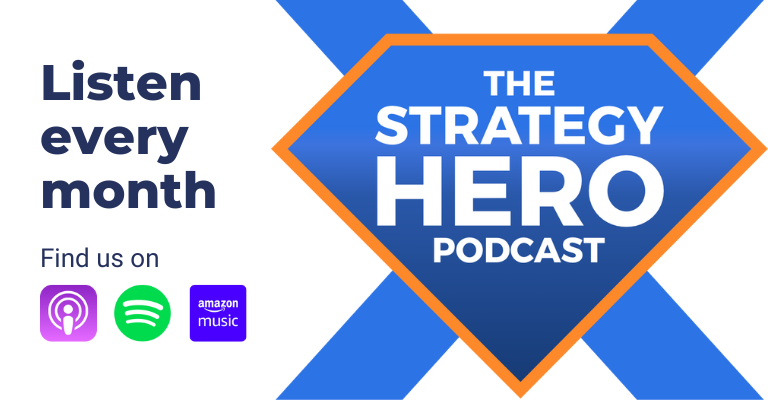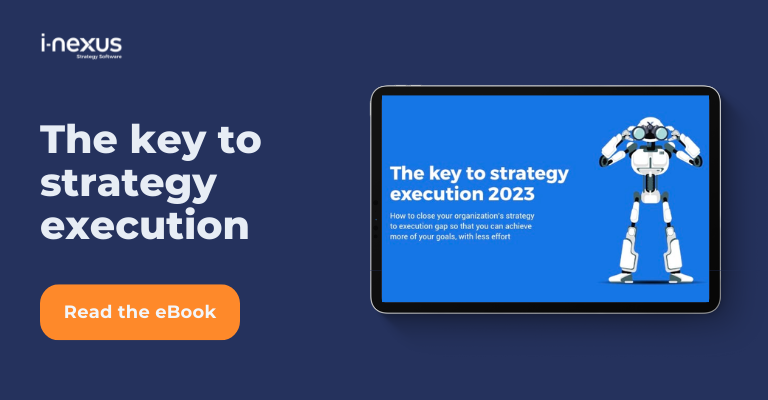With our second episode of “Strategy Hero,” we wanted to keep the change theme strong but approach it from a more focused angle - digital transformation. The first Chief Digital Officer for the UK Department of Health was exactly who we were looking for.
When building our format sheet for the second episode, it would've been easy to get lost in the list of achievements of my guest - Rachel Neaman. Sitting at the top was wrestling with the behemoth that was the UK's journey toward digital health. As soon as we hit record, it was clear why she was that successful.
Here's what I took away from my time with Rachel and our second episode, "The past, present, and future of digital transformation."
It’s important to note that my opinions do not reflect those of i-nexus or Rachel Neaman.
Enjoy!
Formatting the episode
The podcast's second episode needed to continue the quality we'd seen from Pascal's opener around innovation and Lean.
Going through her career, we noticed that Rachel had (ironically) one constant - change.
So, we naturally wanted to dive deeper into that thread and understand what it looked like to tackle change in every role she'd held.
From the very start as the UK Department of Health's Chief Digital Officer through charitable work with Go ON UK, a NED for SaaS provider Checkit, to Advisor to Digital Leaders and beyond, she's been a leader for organizations who need to embrace digital change.
Rachel was the perfect guest to dive into the heart of change, and to grapple with the idea that change is now constant, and this change is constantly developing.
“In less than 20 years, [Apple] released 34 different models, and that's a huge number, and that's just one particular company. In 2023, absolutely everything that we do socially, politically, economically, at home work, with our friends is dictated and defined by data and by digital technology. So it's become an absolute full part of everything we do.”
Change in technologies, processes, and change in our mindset
I feel that when we think about digital transformation we frame our understanding in two camps - technology and process. And something Rachel said drove home the forgotten third camp - people:
“So, alongside that quick pace of change, we have to adapt to that. Businesses have to adapt to that. Systems and organizations have to adapt to that. And what we're finding is that it's very difficult to keep up.”
As Rachel continued, it drove home what is the reason that we shy away from dealing with the human aspect of change in digital transformation - it's difficult to get right. So why is that?
We're naturally opposed to change. We talk about the adoption curve because you can (almost) neatly arrange people into groups regarding new products or services - innovators, early adopters, the majority (early and late), and laggards. That's not a grouping that's been stumbled upon.
We move on the spectrum of that curve, dependent on the change at hand. So, it's hard to have a one-size-fits-all for managing this change.
That's because change is subjective, and dealing with emotions and judgment is hard. That led me to ask Rachel whether the reluctance to change was situated in the leadership ranks, at the shopfloor level, or was something that existed in pockets around the business.
Her answer was the latter, but she brought it back to the need to bring the right approach to the change itself and effectively communicate the rationale of change - a subject we tackle in our Key to Strategy Execution eBook:
Starting with "why"
Simon Sinek's "Start With Why" has been read by millions, and I'm glad to say I'm one of them. Simon doesn't talk in a product, marketing, sales, Lean, or business language - he makes change and purpose relatable.
The whole idea of "why" boils down to a clever way to inspire and connect with others: start by unraveling the deeper reason or purpose behind what you're doing (the "why") rather than just focusing on the what or how. This way, people can emotionally connect and grasp the true value and motivation behind your actions or ideas.
It makes sense. We're more likely to change when we understand why we should do something. Sure, it's hard to get workforces to change, but it's much easier if you can take people on a journey to understand why to do something better.
"I think part of the secret to successful change is being very people-centered in the way you go about that change.
If you can tell somebody in your workforce, and actually their job is going to be easier, their job is going to be more efficient, their job is going to be more productive. These are very positive things.
People go to work to do a good job. Nobody goes to work to do a bad job. And if they feel that this is being done to support them and help them and that you put it in place the right training, support, communication around it, then you're much more likely to succeed."
Making change human
As Rachel continued, she shared her five factors for making the process of change more human:
- Start with why
- Find the early adopters
- Get early adopters onside
- Make benefits and outcomes relevant to your audience
- Make the whole process inclusive
These are very logical steps.
When building momentum, you need to create that "why." But it's not something that should find its roots in teams or management levels - it has to start from the very top.
How you create your vision is not the focus here (but this blog will help). It's important to have motives that move your employees. You do that by crafting a story demonstrating the benefits that resonate with your audience. Like all good storytelling, make your audience the hero.
And it's not about technology...
"Only 30% of transformations succeed... [and] it's often because transformations focus primarily on purely the technology. This is a transformation. We need a new system. Technology will do it all. We need to bring in IT. Let's get in an incredibly expensive system, job done.
Absolutely not. The... 30% of transformations that are successful are because it isn't all about the technology. So again, it's the cultural change that is the most important and often the most difficult to achieve."
As Rachel explained, this change story has to be about more than technology (technology is a tool to help embed the change).
The change must be endorsed by the CEO and the rest of the Cx - it's not about the IT or Transformation Director. With that clear vision, you can communicate the story that's about to unfold in a way that creates fellowship.
Once that's done, the early adopters will voluntarily raise their hands - these are your change agents. They'll pop up across your business, ready, willing, and able to spread their enthusiasm for innovation. It's your job to help channel that excitement.
You channel the excitement with personalized benefits and messaging to those affected by the change. That's why stakeholder analysis templates exist; after all - it's all about making the change human.
My takeaway
Given the sheer amount of digital transformation content available to us, it would always be key for this episode to bring an angle that would be genuinely helpful to you.
I'm confident, looking back, that we achieved that. Rachel talked about table stakes around transformation, but the real value kicked in once she addressed the elephant in the room - technology isn't the answer to succeeding with digital transformation.
"Technology is the enabler. Technology is not the end, it's the means to the end. And very often, people forget that, and senior leaders think, if I just bring in a lot of technology, everything will be fine. And it won't."
It's important to identify and accept the need for change, often driven by external factors like customer buying behavior, but this can also be regulatory or budgetary.
From there, you focus on your people and processes before addressing the tools and technologies to help you on your transformation journey.
It's about being digital, not doing digital. It's about improving business processes, communication, and customer service.
No matter your industry or sector, it's all about finding the why of change and letting everything flow from there.
Listen back to the episode
Rachel's episode was the second of six in our opening season of Strategy Hero.
You can click here to listen to Rachel's episode or search "Strategy Hero" wherever you find your favorite podcasts.
About Strategy Hero
Published on the last Thursday of every month, the Strategy Hero podcast delves into the world of business strategy and transformation.
Each cast shines a spotlight on a Strategy Hero – inspirers, boundary pushers, and leaders of change from all walks of life – armed with practical advice on achieving your goals.
Episodes explore topics around operational excellence, Lean management, process improvement, change management, and much, much more. Available where all great podcasts live, listen on-demand today, and discover the Strategy Hero inside you.
About the host
James Milsom is Head of Marketing at i-nexus, but James is a storyteller. He’s the UK’s biggest Georgia Bulldogs fan (Go Dawgs!) and lives and breathes marketing.
The Strategy Hero podcast is his opportunity to bring some of his conversations with mentors, inspirers, and people anew to you every month.
He’s behind the content read and watched by people like you and lives to educate and help others.
If you’d like to learn more about him, connect with him on LinkedIn and subscribe to the Strategy Hero podcast today!




.jpg?width=352&name=KPIs%20(3).jpg)